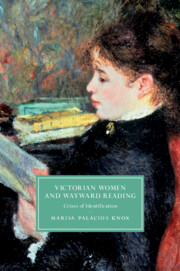Book contents
- Victorian Women and Wayward Reading
- Cambridge Studies in Nineteenth-Century Literature and Culture
- Victorian Women and Wayward Reading
- Copyright page
- Dedication
- Contents
- Figures
- Acknowledgments
- Introduction
- Chapter 1 Masculine Identification and Marital Dissolution
- Chapter 2 Novels without Heroines: Sensation and Elective Identification
- Chapter 3 Character Invasion and the Victorian Actress
- Chapter 4 Antipathetic Telepathy: Female Mediums and Reading the Enemy
- Chapter 5 “The Valley of the Shadow of Books”: The Morbidity of Female Detachment
- Chapter 6 The New Crisis: Can We Teach Identification?
- Notes
- Works Cited
- Index
- Cambridge Studies in Nineteenth-Century Literature and Culture
Chapter 4 - Antipathetic Telepathy: Female Mediums and Reading the Enemy
Published online by Cambridge University Press: 30 October 2020
- Victorian Women and Wayward Reading
- Cambridge Studies in Nineteenth-Century Literature and Culture
- Victorian Women and Wayward Reading
- Copyright page
- Dedication
- Contents
- Figures
- Acknowledgments
- Introduction
- Chapter 1 Masculine Identification and Marital Dissolution
- Chapter 2 Novels without Heroines: Sensation and Elective Identification
- Chapter 3 Character Invasion and the Victorian Actress
- Chapter 4 Antipathetic Telepathy: Female Mediums and Reading the Enemy
- Chapter 5 “The Valley of the Shadow of Books”: The Morbidity of Female Detachment
- Chapter 6 The New Crisis: Can We Teach Identification?
- Notes
- Works Cited
- Index
- Cambridge Studies in Nineteenth-Century Literature and Culture
Summary
This chapter analyzes the Victorian figure of the female medium as another embodiment of wayward reading. In both nonfictional and fictional portrayals of telepathy, or “brain-reading,” female mediums represent a model of identification that is neither passive nor manipulative but defensive. This model also provides a corrective to recent popular accounts of scientific studies that conflate enhanced Theory of Mind (the ability to recognize and interpret the beliefs and emotional states of other people) with actual compassion as an effect of reading literature. Though mediums sometimes represented their ability to communicate with dead and distant minds as an unwanted gift, accounts of spiritualism depict telepathy as directed and purposeful, and not always sympathetic. In her memoir novelist and actress Florence Marryat recounts using clairvoyance in order to understand the disposition and plans of both declared and secret enemies. Mina, the heroine of Dracula (1897), can reverse the direction of mind-reading between herself and the villainous Count, and use her access to his perspective to help defeat him. The feminized type of the Victorian medium deploys her stereotypical sensitivity not always as an effusion of beneficent feeling but as a social strategy to protect herself from predatory and intrusive others.
Keywords
- Type
- Chapter
- Information
- Victorian Women and Wayward ReadingCrises of Identification, pp. 97 - 118Publisher: Cambridge University PressPrint publication year: 2020

